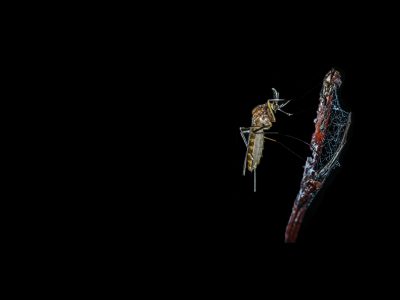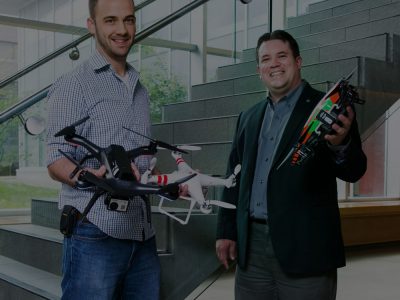By Dan Rubinstein
A nurse in a remote northern community is performing a complex medical procedure with real-time video support from doctors in the south.
A federal government agency in Ottawa is monitoring foreign ships and aircraft approaching Canada’s coastline.
A family on a backcountry canoe trip in Northern Ontario has encountered a dangerous forest fire and needs to arrange an evacuation.
All three of these scenarios require flawless and fast wireless connectivity, but this remains elusive in a geographically vast country with incredibly rugged terrain.

Carleton University Systems and Computer Engineering professor Halim Yanikomeroglu
The solution, according to Carleton University Systems and Computer Engineering professor Halim Yanikomeroglu, involves the integration of terrestrial and non-terrestrial communications networks to create what he describes as a “very big three-dimensional mesh.”
Yanikomeroglu envisions a constellation of technologies — including cellular base stations on the ground, high-altitude platform stations (HAPS) on blimps and other uncrewed aircraft, and low Earth orbit (LEO) satellites — that communicate with each other and can also link directly to smartphones.
“It will be the dawn of a new era,” says Yanikomeroglu, one of the world’s foremost non-terrestrial networks (NTN) researchers and one of the principals behind the Non-Terrestrial Networks for Accelerating Canada’s Ubiquitous Connectivity and Digital Future (NTN-CAN) project.
“Until recently, these ideas may have sounded like science fiction, but we will start to see many of these developments within the next 10 years. The NTN area is emerging very quickly, and both Carleton and Canada have the potential to be leaders in the upcoming wireless communications revolution.”

Connectivity a Human Right
The United Nations considers connectivity a human right, something that’s increasingly essential for health, safety and economic opportunity.
As cellular networks evolve from 5G to 6G over the next half dozen or so years — a faster system with lower latency and greater capacity — today’s telecommunications technologies won’t be able to handle the demand.
One of the challenges is that signals are currently routed from satellite to satellite, with frequent switching. These handovers disrupt connectivity, impacting ground-based users such as navigation systems that require continuous, stable connections.
Moreover, while people are generally tolerant to connectivity interruptions, the digital machines and autonomous systems that are steadily becoming a bigger part of our daily lives are less adaptable.

Yanikomeroglu and members of his research team
Another significant challenge, according to Yanikomeroglu, whose research focuses on the convergence of standalone systems, is that satellite networks and terrestrial networks don’t interact. Satellite data has to be received by an antenna on the Earth’s surface and then conveyed to your phone, although this summer, telecommunications company T-Mobile will be piloting a new technology in the U.S., partnering with Starlink to allow customers to text and use the internet via direct links to satellite networks.
To Yanikomeroglu, this type of “ubiquitous connectivity” is what NTN can deliver, albeit on a much wider scale.
“We really can’t talk about ubiquitous connectivity in Canada without NTN because of our geography,” he says, noting that while cellular towers provide high-speed service in densely populated areas, the number of base stations required to support the same connectivity in rural or remote regions is not sustainable, economically feasible or even possible.
Beyond health and safety, effective NTN will also help protect Canada’s sovereignty, monitor habitat and support key sectors such as forestry, mining and energy development.
“This is essential for Canada,” says Yanikomeroglu, “and we’re moving toward it step-by-step.”

Cooperative Networks and Smoother Communication
One of those leaps forward took place late last year, when Carleton’s Industry and Partnership Services office secured an agreement with Canadian company MDA Space to commercialize a novel satellite network architecture developed by Yanikomeroglu, former postdoctoral fellow Mohammed Abdelsadek and adjunct research professor Gunes Karabulut Kurt.
This patented technology will allow LEO satellites to address the high handover rates that plague current systems. Rather than connecting users to a single satellite, the new model links ground terminals to clusters of satellites, forming cooperative networks that ensure smoother communication.

Yanikomeroglu and former postdoctoral fellow Mohammed Abdelsadek at the Carleton IP Impact Awards at CU@Kanata
These clusters use a cutting-edge method of sharing data between satellites called high-speed inter-satellite links, with data processed through a central unit on an advanced satellite. As a networked group, the satellites ensure more reliable data transmission, reducing the frequency of handovers.
“In addition to mitigating the frequent handover problem, this Carleton invention has another major potential: an important step towards satellite direct-to-smartphone connectivity,” says Yanikomeroglu, whose team received the inaugural Carleton IP Impact Award at CU@Kanata in May for this advance.
Moving forward, Yanikomeroglu recently opened the Carleton Non-Terrestrial Networks Lab, and he and an array of partners — including Communications Research Centre Canada, National Research Council Canada, MDA Space, Telesat, Honeywell and others — are seeking significant funding from the Canada Foundation for Innovation to continue this work.
“This is an important strategic direction for Canada,” he says, “and Carleton is one of the trailblazers in this area.”
First wide image by Pavel Muravev / iStock
Second wide image by BlokPhoto / iStock
Monday, July 21, 2025 in Engineering, Faculty of Engineering and Design, Research
Share: Twitter, Facebook



